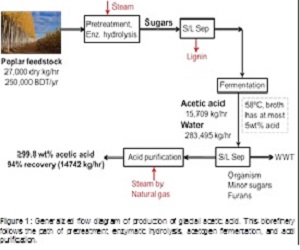
Rodrigo Morales-Vera
University of Washington, USA
Title: Glacial acetic acid production from bioconversion of poplar biomass: Techno-economic assessment and environmental impacts
Biography
Biography: Rodrigo Morales-Vera
Abstract
Current commercial production of glacial acetic acid is exclusively by petrochemical routes with a current market price of $550-850/ton. Acetic acid is an intermediate for the production of plastics, textiles, dyes and paints. Production of acetic acid from biomass might be a sustainable and economically feasible alternative to petroleum derived routes. However, when producing pure acid from biomass, conventional liquid liquid extraction (LLE) using ethyl acetate for acetic acid purification is a major expense and requires considerable energy. The purpose of this study is to evaluate and compare technical and economic feasibility of glacial acetic acid production using ethyl acetate and a tertiary amine (Alamine) in kerosene as organic solvents for LLE purification. Acetic acid production follows the path of pretreatment, enzymatic hydrolysis, acetogen fermentation and acid purification. To meet large energy requirement for the processes, different energy sources including combustion of natural gas and lignin supplemented with natural gas were investigated. Aspen Plus software was used to simulate a biorefinery processing 250,000 tons/year poplar, producing in average 136,300 tons/year of glacial acetic acid. Capital and operating expenses for each configuration and profitability using discounted cash flow analysis to establish minimum selling prices (MSP) were used to assess economic viability. Additionally, Life Cycle Assessment is used to investigate environmental impact. Alamine in kerosene consumed 56% less energy than ethyl acetate during the recovery of acetic acid. Total capital expenses, in average, were 19% lower when natural gas was used as source of energy. The MSP/ton of acetic acid ranged from US$677 to US$819, for the different scenarios. Largest source of greenhouse gases (GHGs) is the combustion of biomass and natural gas at the biorefinery. Compared to petroleum based acetic acid, the global warming potentials (GWP) could be reduced by 41% using lignin and natural gas for bio acetic acid production.


